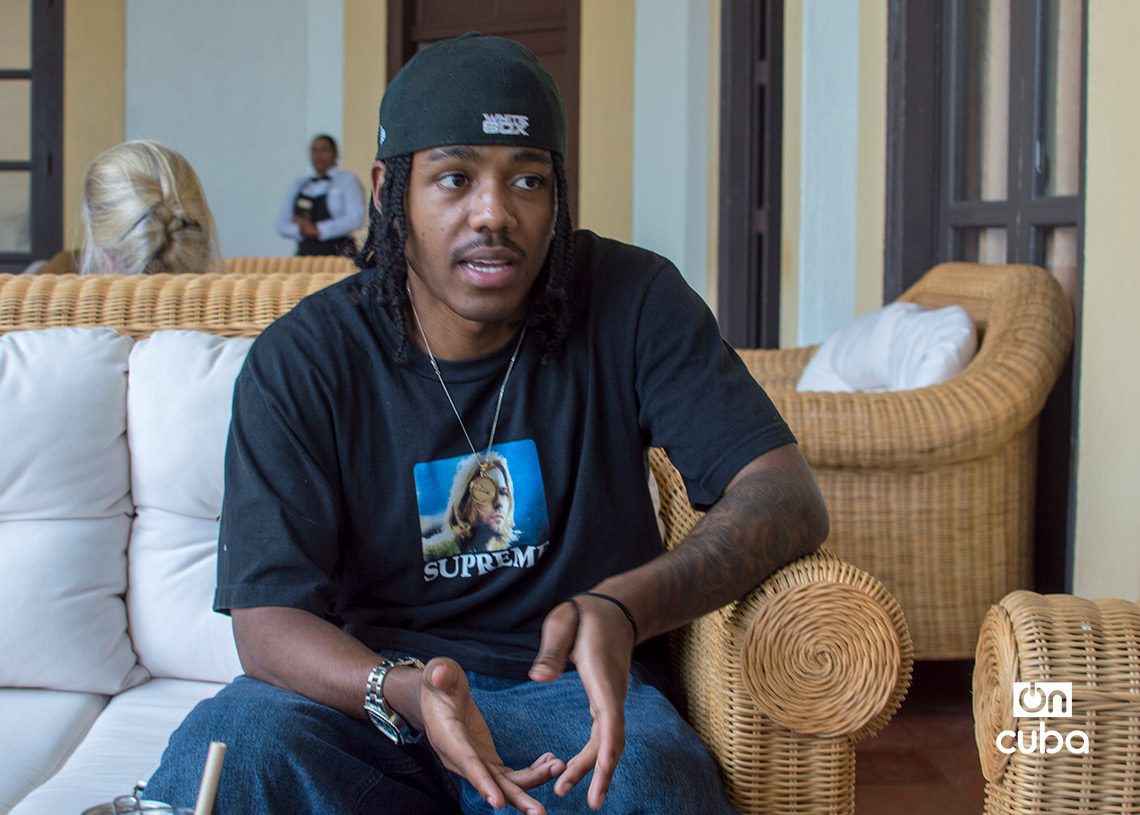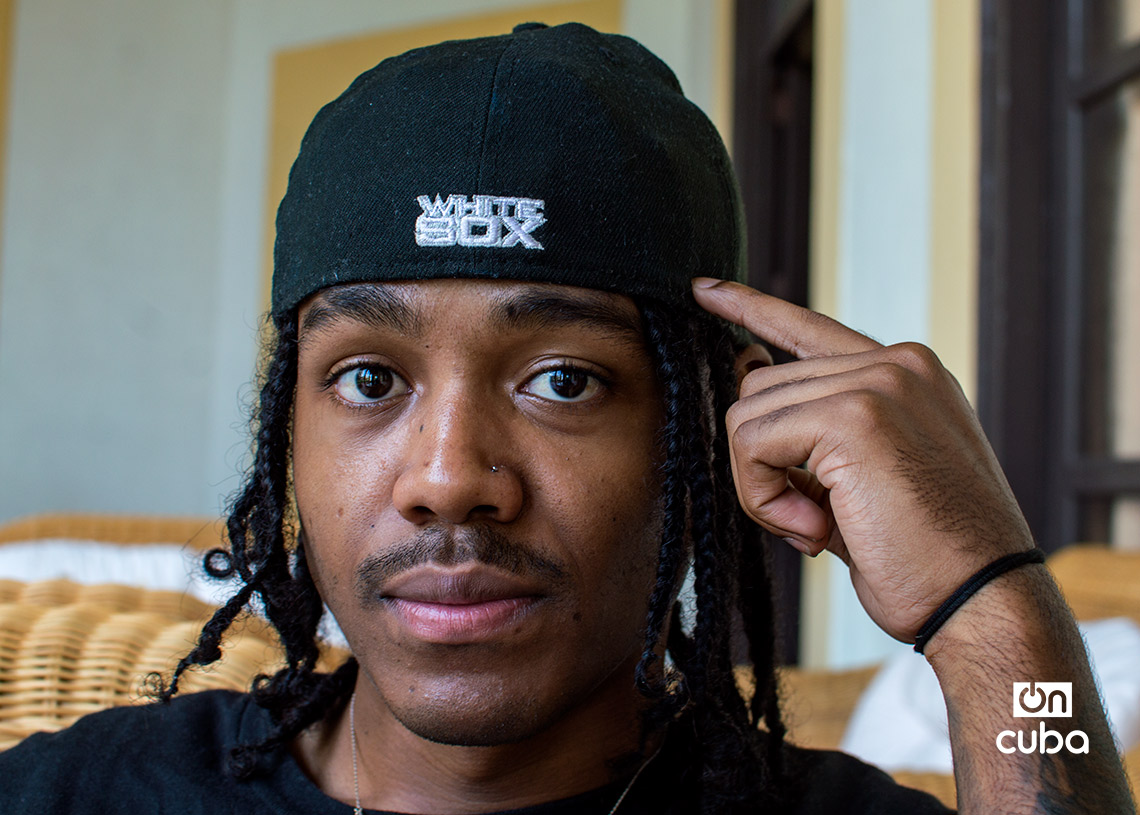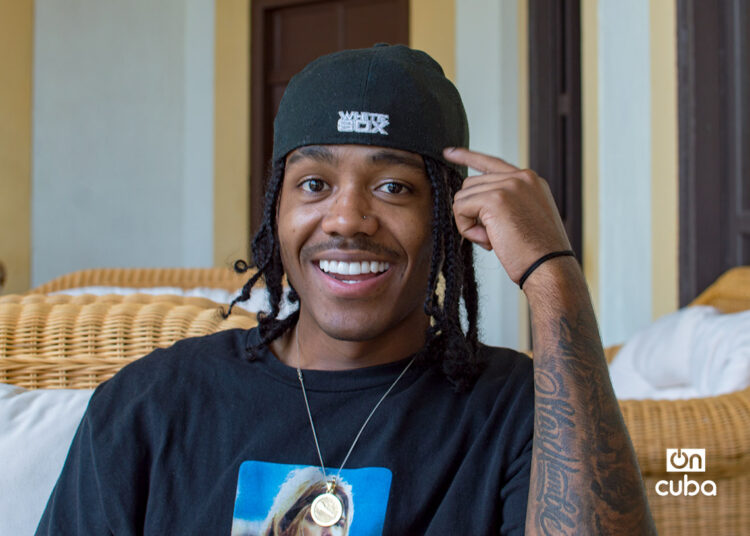I don’t think there are many people in Cuba who haven’t heard a song by Wampi. Whether by choice or unwittingly, in that forced musical update that comes to us in a taxi, on the bus, in a coffee shop, at the gym, at the agricultural market, at the hair salon or at the barbershop…because in Cuba music is heard everywhere, even in places we sometimes don’t want it to be. In that sphere, reparto has managed to consolidate a majority.
Wampi is one of its most popular artists of that genre and the first Cuban reparto performer to become a voting member of the Grammy Recording Academy.
At the last edition of the Varadero Josone Festival, he starred in the event’s most special concert, with a performance that saw the dawn break in front of more than 3,000 people, who attended despite the heavy rains that night. “That was the most beautiful concert I’ve ever experienced because of the audience’s energy,” Wampi tells me as we chat briefly before beginning the interview.

The musician has just released his first album, El Rey de La Habana, with which he is showing how far the genre can go although, he states, “I didn’t make this album so people would be more accepting of reparto.”
His work in recent months has focused on this album, which has been available in full since October 4 and has generated a lot of buzz since the first singles began to be released.
“It’s an album that was, I’d say, somewhat improvised, and everything happened little by little. The pieces of the puzzle appeared: there were songs I’d already written in advance and included them on the album, but I did many instantly. I’d go to the studio one day, meet with Colombian, Cuban and Dominican producers, and we just flowed; that’s how most of the songs were created. There were also last-minute songs, like ‘Rica y To,’ which is one of the most successful, and ‘Tingily’ with Harrison and Adonis MC. I wrote those three or four weeks before the album came out. It was all very fast: recording the videos, defining the marketing strategy…and that’s how it all came together,” Wampi tells us.
The album includes solo tracks and several collaborations with artists such as Formell y Los Van Van, Cimafunk, Leoni Torres, Maffio, Harrison, and Adonis MC, showcasing the musical diversity of El Rey de La Habana. The song “La Última,” featuring Leoni Torres, topped the poll of Billboard’s New Latin Music at the end of June. In total, the album features thirteen tracks and guests such as the duo Ibeyi and Colombian singer Jhosy.
“The guests were carefully chosen for each song, because it was them. I’m a producer; I like producing more than even singing. There are songs I write thinking of an artist who can accompany me, and if the artist can’t, I record it alone, no problem. But, for example, the song with Los Van Van was written during a rehearsal, and I said that if I didn’t record with them, the song wouldn’t be released. I wrote to Lele, he responded, everything flowed, and that’s how ‘Chacha’ was born, which I love. It was the same with almost all the artists on the album: everything happened naturally, nothing was forced, and each person fit perfectly into each song. I don’t feel like there’s an Achilles’ heel on the album,” explains Wampi.
The release of the cover of the song “Rica y To,” one of the album’s smash hits that has accumulated nearly 4 million views on YouTube, recently sparked one of the most talked-about controversies in the genre: a tirade that sparked widespread responses and attention from the reparto audience.
To present El Rey de La Habana, Wampi organized a party on October 3 at Estudio 50 in Havana that combined music and visual arts. Thirteen plastic artists participated with a work each, created based on a song from the album they had assigned, thus integrating the musical proposal with an ambitious visual project.
“This idea wasn’t mine; Collin came up with it, and I’ve always liked it because I’m a fan of all the arts: dance, painting…and the possibility of making these two artistic spheres interact seemed interesting to me, something that hadn’t been done here in Cuba, at least by urban artists. Along the way, many people appeared who supported me, like Jorge Peré and Cristóbal, who recommended some artists; I suggested others, graffiti friends with whom I share works on the street.
“I chose some for each specific song, but the one who helped me the most was Jorge Peré, because he knew the history of the participating artists best. I loved that everyone accepted this challenge, this ‘craziness’ of ours that emerged in a very short time, and took on the role of representing each theme with their art. I’m very happy; I loved many of the works. There were two that particularly impacted me: one is ‘Nostalgia,’ and the other is by a friend of mine, Lauren Susurro. I was fascinated by that work; I haven’t cried since I saw it, but my eyes watered and my skin crawled. I loved having them and having them be part of the project.
“I hope in a future project I can do something like that, similar or even better. I’m currently learning to paint, and one of the things I’d like to achieve in my career would be to make an album and create the artwork for each song myself, not only from a musical perspective, but also a pictorial one,” he tells us, letting us see that Wampi sets no limits.
Playing with the crown
For the album’s release, the artist presented two meaningful audiovisuals on social media. The first depicted an encounter with himself, with his past, and with the light of the future; the second, a game with a crown — perhaps the long-awaited crown of reparto — that Wampi decides not to wear, laughing ironically.
Why this title for the album?
Because we are all kings, we can all do whatever we want at any time, under any circumstance. There’s nothing stopping us from doing what we want, and with El Rey de La Habana, I literally did what I wanted.
I wanted to merge genres and not limit myself to just reparto. More than an urban artist — which I love to be called, I have no problem with labels — I consider myself a musician: I play bachata, reparto, salsa, funky…I’d even like to play symphonic genres. Labels don’t define me; what defines me is the music.
El Rey de La Habana (The King of Havana) is a young man who dared to do something that not many people dare to try, perhaps out of fear of numbers or followers. I understood a long time ago that I don’t want to make music just to be number one; I want to make music that adds cultural value, that leaves something for the people of my country, for my generation. I want them to know that there’s much more to listen to than reparto. I love reparto and I will always defend it, but there are other things that people might like as well.
El Rey de La Habana is all of us: all those who dream, those who struggle, those who rise up to get ahead. These are the true kings of Havana.

Do you think this way you’re helping to make reparto more recognized as a truly Cuban genre within urban music?
Reparto is already inevitable here in Cuba. I don’t know if institutions recognize it as an autochthonous Cuban genre, and unfortunately this isn’t the first time it’s happened with a Cuban genre: it’s born here, but then other countries sort of take the credit and all the merit for something that was born here. It’s happened with salsa, where they say it’s from Puerto Rico when it’s really from here; with the bolero, they say it’s from Mexico when it’s really from here; and well, many other genres. Guarachas were also said to be from I don’t know what country, and those things were born here.
Reparto has been a little bit distant from everything, also because of the content, or perhaps because of the people who listen to it. But I feel like it’s gradually been scaling up, becoming a bit commercial, as if it’s starting to be more accepted. And I do things because I feel them; I didn’t make this album so people would be more accepting of reparto; I did it because I felt I had to do it that way.
The reparto songs I wrote were because I felt they had to be included. And the other genres I wanted to interact with were because of that, because I wanted to do it, I wanted to get out of my comfort zone. I didn’t want the album to sound the same from song one to thirteen, and that’s why I dared to play a little with other styles.
Is this album more personal than other things you’ve done in your career?
To be honest, it’s not such a conceptual album, but it does have very personal songs. It doesn’t follow a pattern that tells a story from the moment you start with the first song until you finish the thirteenth; it’s like a compilation: songs that I recorded and liked, and I put them in my favorites. Yes, I do think that in the future I want to make an album that’s a little more thought out, a little more conceptual, playing things for entertainment, but also more serious, conscious themes. I know it’s something I can contribute a lot to people of my generation.
You’re one of the few reparto musicians who shares school and the street, two worlds that often seem at odds in urban music. Do you think it’s important to have a formal musical background to do reparto?
It’s always going to be useful, because it teaches you a lot of theory, many things that an empirical person normally wouldn’t know. But I’m very grateful to myself for not having been the best student, because that kept me between the two worlds. I didn’t become a virtuoso musician who learned all the progressions, because that gets to the point of becoming schematized and then you can’t get out of there. That’s why I’m so grateful for my way of being at that time, for perhaps not having paid the attention I needed to school, because there are also many things I’m currently producing that a musician normally doesn’t think about.
I put myself in both positions: I see when something is really wrong, I correct it and I focus on the musical side; but when I see that something is very musical and I know that the people on the street won’t understand it, I put myself on the reparto side, on the side of the street, on the side of the people. But yes, 100% will help you. It’s an advantage that I’m also truly grateful for to my family and my teachers, for the patience they had in allowing me to do what I do today.

You recently said in an interview that when you were studying at music school, you thought about being a jazz musician. Is there any of that dream left?
Yes, I want to be a jazz musician; I have to at least do jazz. I want to experiment with all genres and I have a dream that I know I’m going to achieve. One is that I’d like to study, and I’ll put it this way: I’m going to study at Berklee College.
I want to be that musician who goes to a bar alone at night with an instrument and there’s a group playing, and I go up there with the group and play the saxophone, the piano, the guitar, or whatever needs to be played.
I want to feel that energy as an instrumentalist too, because it’s always like a singer. I’m already using it a little with the saxophone in my concerts, but I want that art of improvising, of being able to create in the moment — I want to feel that. That’s why I’m studying now what I didn’t study in school, and yes, there’s still a lot of that kid who wanted to be a jazz musician and play many instruments.
What has changed since you started your career to the Wampi we see in El Rey de La Habana?
It’s changed a lot. I’ve changed in the sense that now I’m a little more organized; I know all the things I want to achieve; I didn’t before, I just wanted to be heard in Cuba. That’s been achieved in some way, now I want to go a little further, I have other plans, other goals; among them to be a good musician. I want to achieve that in my life: to be a good musician, a good producer, and always also a good person connected to that.
I’ve changed a lot. I didn’t think like that before; I used to just think about singing, getting a song that was a hit, and that’s it, no matter what happens. Not anymore, now the goal is different: to study, prepare for life, opportunities, and be able to represent my country, all Cubans anywhere in the world, so that when people say, “Wampi, that was something else,” that’s my goal.

What moments in your career have led you to these changes?
One of the best things that can happen to me, and I’m very grateful when it happens, is when people underestimate me. That gives me even more strength, not to prove it to them, but to prove to myself that I can do it. I don’t have to prove anything to anyone; that’s something that’s always been clear to me.
The second thing was the team I had before. I had a lot of ideas and we weren’t on the same page, on the same wavelength, and they had to go their way and I had to go mine, so I could do what I wanted and feel happy, because I felt bad about not being able to express many of the things I had inside.
And I think the third critical moment was when COVID hit, when I stopped releasing music. Before the pandemic I was doing really well; afterward, my music declined significantly, and that’s when I realized how the friendships I supposedly had sort of forgot about me. I realized that they loved me for who I had become and not for who I really am, and that opened my eyes, made me realize the people who truly matter in my life: my family, my few close friends, and that’s what has helped me continue to grow and keep going on.
Precisely, your family today also includes an important part of your work team; your brother is your manager….
My brother is more Wampi than I am. I am the voice of Wampi, but my brother is more Wampi than I am. Literally.
My brother was an athlete; he has discipline instilled in him. I was a musician, but musicians are a little crazier. My brother is the person who keeps me going, in the “we have to do this, this, this….’ He’s a perfect complement, and has always been since the beginning of my career. He’s been there from the very beginning, from the moment we went to the studio to record; later, he had to go to the United States to work and I had to stay here alone, but we never lost that connection, and it was as if he were still here.
You could also be in the United States pursuing your career. Why does Wampi maintain his roots in Cuba?
Because God wants me here. There’s something in the universe that wants me here, and I feel good here because, above all, I have my family, which is the most important thing. And yes, I can be in a country that has everything, but if I don’t have my family, I feel like I have nothing. And I’m truly happy to be here, despite everything, the situation, what we’re experiencing here in Cuba. But I have my family, and having my family means having everything for me.
I’m a person who enjoys the simple things in life. I don’t need much, no luxuries, or anything like that, to feel good. And I know that Cuba also needs me to convey a little of the energy I feel, with my family, with my work, with my things. I feel like I have to convey that energy somehow, and that will be through music and art.
What does the Cuban public mean to you?
Everything. They were the ones who made me, and always, wherever I am, I will represent them, with great pride, great affection and great love. That’s my biggest dream: I also want to represent my country, a country, and have people say “Wampi, from Cuba.” That will be something super, super special to me.
What would you title this interview?
“You need to be happy” is my title.
And it reminds us of the graffiti we find in many places in Havana and the end of the music video for the song “Nostalgia,” one of the most beautiful and personal songs of El Rey de La Habana.









